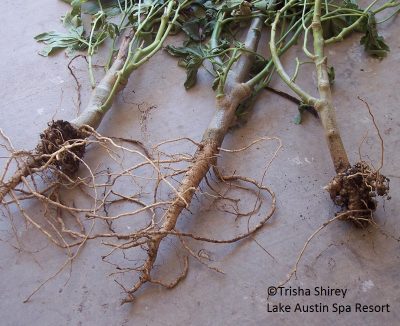Root Knot Nematodes

These parasitic worms infest plant roots and rob them of water and nutrients. They are microscopic worms, but the damage to roots is very apparent. They are more common in sandy soils and can be introduced when soil is added to the garden, from soil on tools and garden implements or from infected plants.
The nematodes distort the roots with root knot galls, very visible when you pull up an infected plant.
These are not nitrogen nodules which are found on the roots of beans and other legumes. Nitrogen nodules can be easily pulled off the plant roots; root knots from nematodes are not removable. These colonies blockade the normal root plumbing, forming stunted, rounded growths. Plants wilt quickly and may look chlorotic or yellowed due to their malnourished state. A soil test can determine how severe the problem is and identify the specific type of nematode that may be present in the soil.
Certain crops are more affected by nematodes than others. Tomatoes, pumpkins and okra may be impossible to grow in severe nematode infestations. Peppers, cucumbers, beets, watermelons and eggplants and even roses are affected to a lesser degree. They rarely kill woody plants like trees and shrubs, but can weaken them and make them more susceptible to other problems. Nematodes rarely affect our cool season crops other than late carrots as they are not active in cool soil, below 64 degrees.
They may never be completely eradicated but there are measures to control them so that crops can be successful.
- Increase organic matter in the soil to encourage the life of beneficial soil microorganisms.
- Drip irrigate to avoid plant stress and mulch plants well.
- Plant nematode resistant varieties. Tomatoes will have the letter N to indicate resistance. (See below for a listing of resistant varieties.) Use Nemaguard rootstock for fruit trees and Freedom rootstock for grapes.
- Plant spring and summer crops as early as possible to get a jump start on growth before nematodes are a problem.
- Use chitin containing products like Clandosan to the soil in advance of planting. The nematodes have a chitin shell and microbes that are stimulated by the introduction of chitin will help to reduce nematode numbers. (This can attract flies. You may want to use light weight row cover over treated areas.)
- Add cornmeal to the soil to boost soil life.
- Treat soil with Actinovate, a biological fungicide. Expensive to use, but only takes 6 ounces per acre.
- Treat with sesame oil products. (Dragonfire, Ontrol, Nemagard)
- Monterey has a Quillaja saponaria extract (Chilean soapbark tree) that is labeled as an organic means of control of nematodes.
- Plant cereal or elbon rye in the cool season. Cut it back before it seeds and turn into the soil several weeks before planting time.
- Allow the soil to be fallow for a season, keeping the soil moist and turning soil often to expose it to the sun. This can lead to weed problems, many of which can be nematode hosts.
- Solarize for 4 to 6 weeks in summer to kill off much of the nematodes in the top layers of soil.
- Use French marigolds, mustards and brassicas, castor beans as repellant crops. They produce chemicals toxic to nematodes. Follow nematode sensitive crops with these plants.
Plants Not Affected by Nematodes
- Corn
- English Peas – Wando
- Tomatoes – Beefeater VFN, Beefsteak VFN, Carnival, Celebrity, Early Girl, Roma II, Lemon Boy, Small Fry, Sweet Chelsea, Tycoon, Viva Italia
- Sweet Potatoes – Jewel, Nugget, Red Jewel
categories:
tags:
related:
appeared on episodes:

 Trisha Shirey
Trisha Shirey